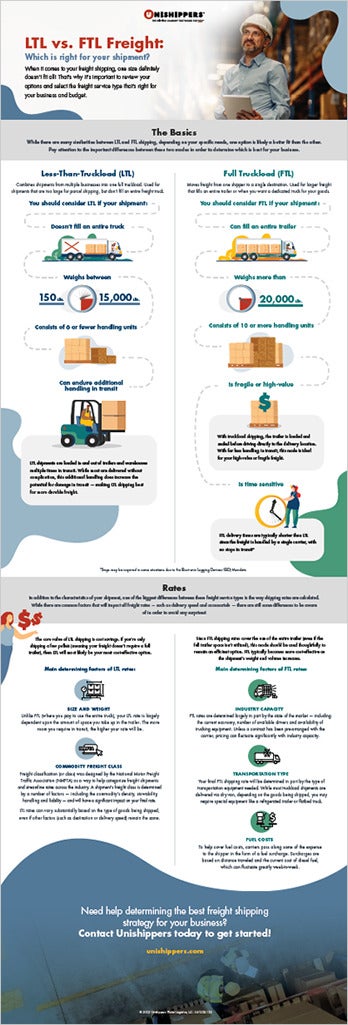LTL vs FTL: Guide To Comparing Freight Shipment Service Types
While there are many similarities between less-than-truckload (LTL) and full truckload (FTL) freight shipping, depending on your specific needs, one option is likely a better fit than the other. Download our "Truckload vs. LTL Freight" infographic to learn the differences between these two modes and determine which is right for your business shipping.
What's the difference between LTL shipping and FTL shipping?
LTL stands for less-than-truckload shipping. This option is used when shippers have a lower freight volume that can't fill an entire trailer, but still want their goods to hit the road right away. If your small or mid-sized business (SMB) is in need of cost-effective freight services, LTL shipping could be the perfect option.
Full truckload, also known as FTL freight, is a shipment type used when your freight can fill an entire truck (or if you simply need a dedicated truck for your goods). This is a great option if you're dealing with freight that fills an entire trailer, contains fragile or high-value materials or needs to arrive quicker than usual. Read about our FTL freight shipping services to learn more or get a quote today.
When it comes to LTL vs FTL, the best choice for your business may seem clear when looking at these two freight modes, but in many cases there's more to consider than shipment size alone. Our infographic details other essential FTL and LTL freight differences you'll want to understand before making a decision.
FTL or LTL Freight: Choosing the right freight mode
When choosing between FTL and LTL shipping, consider the following:
- Is the shipment large enough to fill an entire truck?
- Will the shipment be going to a single location?
- Does the shipment contain fragile or high-value items?
- How many handling units will the shipment contain?
- What is the total weight of the shipment?
By understanding the subtle differences between LTL and FTL freight, you can make the best, most cost-effective choice for your business. Download our helpful infographic to decide which shipping method best suits your business's unique shipping needs.



